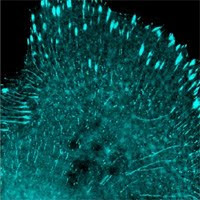Murine pluripotent stem cells can exist in two distinct states, blastocyst-derived LIF-dependent embryonic stem cells (ESCs) and epiblast-derived bFGF-dependent stem cells (EpiSCs). Murine ESCs and similar iPSC lines are more of the “ground-state” in terms of developmental status, as reflected by the lack of X chromosome inactivation in female cells and their abilities to pass as single cells. Human iPSCs, like human ES cells, are more similar to mouse EpiSCs. Unfortunately these human pluripotent stem cells are difficult to genetically manipulate, e.g. knockin or knockout. They also grow slowly, with doubling time averaging 36 hours. In order to create ground-state human iPSCs, several approaches have been tested, including reprogramming iPSC-derived fibroblasts, continuously expressing 5 iPS factors (Oct4, Sox2, Nanog, c-Myc, and Klf4), or using chemicals to inhibit chromatin modifying enzyme HDAC. While these approaches succeeded to certain degrees, the resulting cell lines seem to have some limitations, such as limited passage numbers.
Retinoic acid (RA) signaling is involved in many aspects of embryonic development. RA receptor (RAR), together with one of its heterodimerization partners, steroid hormone receptor Lrh-1, was recently found to be able to synergize with the 4 common iPS factors (Oct4, Sox2, Klf4, and c-Myc) to induce mouse and human fibroblasts into ground-state iPSCs. The pluripotent cells created by the so-called F6 factor combination show no X chromosome inactivation if from female origin, can fully activate the endogenous Oct4 promoter, express Rex1 (which is specific to mouse ESCs, not EpiSCs), and grow with a 16 hour doubling time. All these mouse ESC-like features were achieved without detectable expression of the exogenous factors once iPSC colonies formed, indicating transient F6 expression is capable of effectively initiating endogenous stem cell factors. Remarkably, these stem cells can maintain their undifferentiated status in mouse ESC medium for 50 passages or more. This work, published this month in Proceedings of National Academy of Science USA [1], provided the stem cell research and application field with a very desirable choice of human stem cells.
As opposed to ~16 days with F4, it appears that the time required to induce adult fibroblasts into pluripotent stem cells is as short as 4 days if F6 factors are introduced on a murine stem cell virus (MSCV) vector with an integrated piggyback transposon. As the authors noted in their discussion, the speed-up benefit should be particularly advantageous for transient transfection approaches such as mRNA reprogramming. The bottom line from this paper and the engineered factor papers (see the previous AlleleBlog article under “iPS and other Stem Cells”) is that iPSC reprogramming is only going to get faster, which means that hopefully in the near future creating iPSCs will become a routine experiment as easy as a simple transfection.
Wang, W., J. Yang, et al. (2011). “Rapid and efficient reprogramming of somatic cells to induced pluripotent stem cells by retinoic acid receptor gamma and liver receptor homolog 1.” Proc Natl Acad Sci U S A.
New Products of the week: ARCA, modified cap analog for in vitro transcription of mRNA.
Promotion of the week: Friday special this week, 15% off all iPS viral particle products if using code “ViraliPS” when ordering online at allelebiotech.com, by email, or fax.




